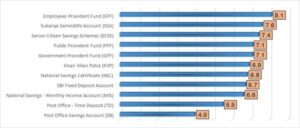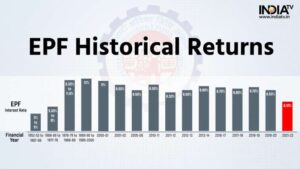EPF account contributions are done by the employee as well as the employer. The employer deposits the amount into the EPF account of employees directly on a monthly basis.
EPF Interest Rate Cut: 2021-2022
The Employees’ Provident Fund Organisation (EPFO) has cut the interest rate on EPF of 8.1 per cent for the financial year 2021-22 to a 40-year-low. This causing more pain to the salaried class at a time when inflation is at an 8-year-high. For the financial year 2020-21 the interest rate was 8.5 per cent.
The announcement was made on 3rd May after ratification by the Central government. Finance Minister Nirmala Sitharaman in March strongly defended the EPFO decision to cut the interest rate. She had mentioned in the Rajya Sabha that the rate is dictated by today’s realities where the interest rate on other small saving instruments was even lower. Sitharaman referred to returns on government-backed small saving schemes that offer safe and assured returns to make her case.
Sitharaman was absolutely right on this. A quick comparison between the interest rate on EPF and other the government’s small savings schemes shows that the EPF is a lucrative destination to park funds for a fixed return.
EPF vs PPF, SCSS, Sukanya Samriddhi
Schemes like Public Provident Fund (PPF), Senior Citizen Savings Scheme (SCSS), Sukanya Samriddhi, State Bank of India’s (SBI) ten-year fixed deposit, Post Office saving schemes like Time Deposit Scheme (similar to bank FDs), Monthly Income Scheme, savings certificates like the National Savings Certificate and the Kisan Vikas Patra are tested by times and considered to be safe mode of investments. These schemes don’t offer quick returns, but in return they are much safer because of the government backing than the schemes linked to the equity market. It is worth to mention here that the yield on 10-year government bond is currently below 7%.
EPF Historical Returns
EPF interest rate was 3% in FY 1952-53, which gradually increased to 8% in 1977-78 and then 12% in 1991-92.
It is important mentioning here that EPF contribution too enhanced gradually since 1952-53 when 1 aana per Rupee was payable on total basic wages, DA and food concession by both employee and employer.
EPF Still Remains Best Bet – 5 Reasons
1. EPF Mandatory Clause
EPF contribution is mandatory for all salaried person. As per the rule, 12% of the basic salary and DA is to be credited to the EPF account every month. We don’t have a choice here to stop the contribution. We have to save regularly irrespective of our will. This mandatory clause allows EPF to score better than other schemes.
It can be great deal for those who are making additional investment (more than 12%) in voluntary provident fund (VPF).
2. Contribution to EPF
Total contributions towards EPF accounts are done by the employee and the employer both. The employer deposits the calculated amount into the EPF account of the employees directly on a monthly basis. While the employee contributes 12% of basic salary and DA, the employer also contributes a similar portion of the employees’ salary (8.33% towards the Pension Scheme and 3.67% towards the EPF). Hence, the total contribution in an EPF account becomes 24% of the basic salary & DA.
3. Compounding Interest Rate
EPF interest is yearly compounding. To make it simple, you earn interest on interest on the contributions received. This also makes the EPF a lucrative destination for parking funds to get a handsome return.
The interest is credited at the end of the financial year, though the interest is computed every month.
4. Tax Benefits of EPF
Contributions towards EPF offers tax benefits too! It is considered one of the most tax-efficient tools in India.
It is benifitted the status of Exempt, Exempt, Exempt (EEE). The EPF ontributions are deductible from the salary of an employee and no tax is applicable on this amount. The tax benifit on the contribution can be claimed under Section 80C of the Income Tax Act. Also the earned interest or the maturity amount is absolutely tax free.
In the starting 2021-22, the government introduced a clause wherein interest earned on EPF contributions of over Rs 2.5 lakh is taxable.
Other government-backed small saving schemes also offer tax benefits similar to EPF. But the schemes like SCSS and FDs are taxable.
5. Retirement benefit
EPF is a traditional tool of saving for retirement. Undoubtedly it is a trusted retirement planning avenue. The higher we contribute, the higher we can generate. Along with that, we save tax at three stages – contribution, interest accumulation and withdrawal.
The entire corpus can be withdrawn on retirement (withdrawing before retirement is allowed in certain conditions).
Where EPF Contribution Is Invested
EPF is a debt product. The accomulated funds are invested majorly in debt products like government securities. From 2015, the EPFO was allowed to start investing in equities, but with a limit. The statutory body was initially permitted only 5% to invest in equities. The limit was later on increased to 15% in 2017.
Also read below..
11 Best Term Insurance Plan In India 2022
11 Best Online Trading Platform In India 2022
11 Best Forex Broker in India 2022






